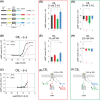Allosteric modulation of adenosine A1 and cannabinoid 1 receptor signaling by G-peptides
- PMID: 33124765
- PMCID: PMC7596666
- DOI: 10.1002/prp2.673
Allosteric modulation of adenosine A1 and cannabinoid 1 receptor signaling by G-peptides
Abstract
While allosteric modulation of GPCR signaling has gained prominence to address the need for receptor specificity, efforts have mainly focused on allosteric sites adjacent to the orthosteric ligand-binding pocket and lipophilic molecules that target transmembrane helices. In this study, we examined the allosteric influence of native peptides derived from the C-terminus of the Gα subunit (G-peptides) on signaling from two Gi-coupled receptors, adenosine A1 receptor (A1 R) and cannabinoid receptor 1 (CB1 ). We expressed A1 R and CB1 fusions with G-peptides derived from Gαs, Gαi, and Gαq in HEK 293 cells using systematic protein affinity strength modulation (SPASM) and monitored the impact on downstream signaling in the cell compared to a construct lacking G-peptides. We used agonists N6 -Cyclopentyladenosine (CPA) and 5'-N-Ethylcarboxamidoadenosine (NECA) for A1 R and 2-Arachidonoylglycerol (2-AG) and WIN 55,212-2 mesylate (WN) for CB1 . G-peptides derived from Gαi and Gαq enhance agonist-dependent cAMP inhibition, demonstrating their effect as positive allosteric modulators of Gi-coupled signaling. In contrast, both G-peptides suppress agonist-dependent IP1 levels suggesting that they differentially function as negative allosteric modulators of Gq-coupled signaling. Taken together with our previous studies on Gs-coupled receptors, this study provides an extended model for the allosteric effects of G-peptides on GPCR signaling, and highlights their potential as probe molecules to enhance receptor specificity.
Keywords: CB1; GTP-binding proteins; N(6)-cyclopentyladenosine; SCH 442 416; adenosine A1; adenosine-5’-(N-ethylcarboxamide); cannabinoid; receptor; signal transduction.
© 2020 The Authors. Pharmacology Research & Perspectives published by John Wiley & Sons Ltd, British Pharmacological Society and American Society for Pharmacology and Experimental Therapeutics.
Figures



References
Publication types
MeSH terms
Substances
Grants and funding
LinkOut - more resources
Full Text Sources
Miscellaneous

